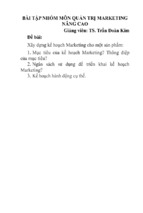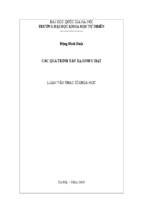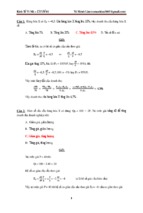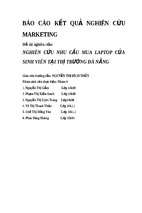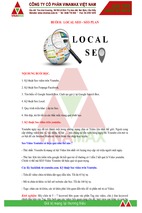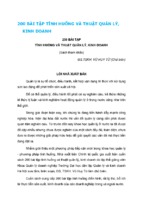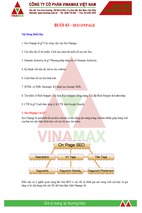International
Marketing Research
Third edition
C. SAMUEL
S U S A N P.
CRAIG and
DOUGLAS
Leonard N. Stern School of
Business, New York University
Allie
International
Marketing Research
Third edition
Allie
International
Marketing Research
Third edition
C. SAMUEL
S U S A N P.
CRAIG and
DOUGLAS
Leonard N. Stern School of
Business, New York University
Copyright © 2005
John Wiley & Sons Ltd, The Atrium, Southern Gate, Chichester,
West Sussex PO19 8SQ, England
Telephone: (+44) 1243 779777
Email (for orders and customer service enquiries):
[email protected]
Visit our Home Page on www.wileyeurope.com or www.wiley.com
All Rights Reserved. No part of this publication may be reproduced, stored in a retrieval system or
transmitted in any form or by any means, electronic, mechanical, photocopying, recording, scanning or
otherwise, except under the terms of the Copyright, Designs and Patents Act 1988 or under the terms of
a licence issued by the Copyright Licensing Agency Ltd, 90 Tottenham Court Road, London W1T 4LP, UK,
without the permission in writing of the Publisher. Requests to the Publisher should be addressed to the
Permissions Department, John Wiley & Sons Ltd, The Atrium, Southern Gate, Chichester, West Sussex
PO19 8SQ, England, or emailed to
[email protected], or faxed to (+44) 1243 770620.
This publication is designed to provide accurate and authoritative information in regard to the subject
matter covered. It is sold on the understanding that the Publisher is not engaged in rendering professional
services. If professional advice or other expert assistance is required, the services of a competent
professional should be sought.
Other Wiley Editorial Offices
John Wiley & Sons Inc., 111 River Street, Hoboken, NJ 07030, USA
Jossey-Bass, 989 Market Street, San Francisco, CA 94103-1741, USA
Wiley-VCH Verlag GmbH, Boschstr. 12, D-69469 Weinheim, Germany
John Wiley & Sons Australia Ltd, 33 Park Road, Milton, Queensland 4064, Australia
John Wiley & Sons (Asia) Pte Ltd, 2 Clementi Loop #02-01, Jin Xing Distripark, Singapore 129809
John Wiley & Sons Canada Ltd, 22 Worcester Road, Etobicoke, Ontario, Canada M9W 1L1
Wiley also publishes its books in a variety of electronic formats. Some content that appears
in print may not be available in electronic books.
Library of Congress Cataloging-in-Publication Data
Craig, C. Samuel.
International marketing research / C. Samuel Craig and Susan P.
Douglas.— 3rd ed.
p. cm.
Includes index.
ISBN 0-470-01095-9
1. Export marketing—Research. I. Douglas, Susan P. II. Title.
HF1416.C73 2005
658.8′4—dc21
2005001265
British Library Cataloguing in Publication Data
A catalogue record for this book is available from the British Library
ISBN 0-470-01095-9 (PB)
Typeset in 10/15pt Sabon by Graphicraft Ltd, Quarry Bay, Hong Kong.
Printed and bound in Great Britain by Biddles, Kings Lynn.
This book is printed on acid-free paper responsibly manufactured from sustainable forestry
in which at least two trees are planted for each one used for paper production.
To Liz, Mary Catherine, and Caroline
(C.S.C.)
To Nicholas and Stephanie
(S.P.D.)
Allie
CONTENTS
About the Authors
Preface
xi
xiii
1
Marketing Research in a Global Environment
Introduction
Complexity of International Marketing
Importance of Research for International Marketing Decisions
Issues in International Marketing Research
Scope of the Book
1
1
4
10
14
19
2
Designing International Marketing Research
Introduction
The International Marketing Research Plan
The International Marketing Research Process
Structuring the Unit of Analysis
Selecting Information Sources
Research Plan
Issues in Administering International Marketing Research
Summary
23
23
25
29
36
37
40
44
59
3
Secondary Data Sources
Introduction
Locating the Appropriate Information
Information Sources
Information Requirements
Summary
63
63
64
71
87
103
4
Uses of Secondary Data
Introduction
Market Entry
Demand Estimation
109
109
110
123
viii
Contents
Assessing Market Interconnectedness
Summary
141
148
5
Structuring Primary Data Collection
Introduction
Defining the Unit of Analysis
Selecting Units of Analysis
Structuring the Research Design
Cultural Bias in Research Design, Communication and Interpretation
Summary
153
153
154
161
163
170
174
6
Establishing the Comparability of Multicountry Data
Introduction
Establishing Comparability: The Emic/Etic Dilemma
Establishing Data Equivalence
Determining Construct Validity
Establishing Construct Reliability
Summary
179
179
180
188
194
195
200
7
Nonsurvey Data Collection Techniques
Introduction
Different Qualitative Techniques
Observational and Quasi-observational Data
Projective Techniques
In-depth Interviews
Summary
205
205
206
210
217
224
233
8
Survey Instrument Design
Introduction
Questionnaire Design and Question Formulation
Type of Question
Use of Nonverbal Stimuli
Instrument Translation
239
239
240
248
250
254
Contents
Potential Sources of Bias Associated with the Research Instrument
Summary
9
Sampling and Data Collection
Introduction
Sampling
Achieving Comparability in Sampling
Data Collection Procedures
Field Staff Organization and Training
Summary
259
271
277
277
279
291
295
303
306
10 Multicountry Scales
Introduction
General Issues in Scale Development
Using Multi-item Scales in Cross-cultural Research
Developing Cross-cultural Scales
Summary
311
311
312
322
335
340
11 Analysis of Multicountry Data
Introduction
Multicountry Data Analysis
Assessing the Differences in the Level of Variables between Countries
Summary
347
347
348
352
374
12 Assessing Differences in the Structure of Variables
Introduction
Correlation Analysis
Means–End Hierarchies
Cluster Analysis
Multidimensional Scaling
Factor Analysis
Confirmatory Factor Analysis
Covariance Structure Models
381
381
382
385
389
394
397
400
406
ix
x
Contents
Advances in Data Analysis
Summary
409
411
13 The International Marketing Information System
Introduction
Information Components of the International Marketing System
Data Collection and Processing for the International Marketing
Information System
Applying the Information System
Summary
419
419
422
14 Challenges Facing International Marketing Research
Introduction
Coping with Change: Marketing Infrastructure and Technology
Contending with Complexity: Conducting Research in Emerging
Markets
Confronting Competition: Marketing Research Services in a Global
Environment
Conforming to Conscience: Ethics in International Marketing
Research
Summary
443
443
445
15 Future Directions in International Marketing Research
Introduction
Comparability and Equivalence Revisited
Developing the Research Design
Improving Analysis of Cross-cultural Data
The Growth of Internet Research
Conclusion
465
465
466
469
473
475
476
Subject Index
Author Index
Acknowledgements
429
434
440
450
454
457
462
479
495
503
ABOUT
THE
AUTHORS
C. SAMUEL CRAIG is the Catherine and Peter Kellner Professor, Professor of Marketing and
International Business and Director of the Entertainment, Media and Technology Program at New
York University’s Stern School of Business. He received his PhD from the Ohio State University.
Prior to joining New York University, Professor Craig taught at Cornell University. He has taught
marketing for executive programs in the United States as well as France, the UK, Thailand, Singapore, Greece and the former Yugoslavia.
Professor Craig has co-authored Consumer Behavior: An Information Processing Perspective (Prentice
Hall) and Global Marketing Strategy (McGraw-Hill). His research has appeared in the Journal of
Marketing Research, Journal of Marketing, Journal of Consumer Research, Journal of International
Business Studies, Columbia Journal of World Business, International Journal of Research in Marketing, Journal of International Marketing and other publications. Over the past 25 years, he and
Professor Douglas have collaborated on a wide variety of international marketing projects including
this book, numerous scholarly articles, and contributions to handbooks and encyclopedias.
SUSAN P. DOUGLAS is the Paganelli-Bull Professor of Marketing and International Business at
New York University’s Stern School of Business. She received her PhD from the University of
Pennsylvania. Prior to joining New York University, Professor Douglas taught at Centre-HEC,
Jouy-en-Josas, France, and was a faculty member of the European Institute for Advanced Studies
in Management in Brussels. She has also taught international marketing in executive programs in
France, Belgium, Italy, Greece, Taiwan, Singapore, India, South Africa and the former Yugoslavia.
A past president of the European Marketing Academy, and former vice-president of the Academy of
International Business, Professor Douglas was elected as a fellow of the Academy of International
Business in 1991 and was Dean of the Fellows from 1999–2002. She was made a fellow of the
European Marketing Academy in 2002 and chaired the Fellows from 2002–2005.
Professor Douglas co-authored Global Marketing Strategy (McGraw-Hill) with Professor Craig.
Her research has appeared in the Journal of Marketing, Journal of Consumer Research, Journal of
Marketing Research, Journal of International Business Studies, Columbia Journal of World Business, International Journal of Research in Marketing, Journal of International Marketing and other
publications.
Allie
PREFACE
In the relatively short time since the second edition of International Marketing Research appeared,
there have been rapid and dramatic changes in the field. As firms increasingly expand operations in
countries outside their home market, they require marketing research to guide decision making.
Industry consolidation of research firms has accelerated as they strive to better serve global clients.
The Internet has burst on to the scene as an alternative way to gather information and conduct
surveys rapidly. Increasingly research is being conducted in developing countries as firms expand
operations into markets such as India and China. The third edition of the book is completely
updated to reflect changes in both the structure and practice of international marketing research.
Generally speaking, the volume of commercial research on international markets has expanded
more rapidly than academic research. This is particularly true within the EU and nearby countries,
where market integration means that researchers continually face the challenges of conducting
research spanning multiple cultures and countries. At the same time, as firms continue to expand
operations in Asia and Latin America, the need for information to plan or adapt strategy to these
markets is growing. Progress in academic research, on the other hand, has been hampered largely by
the complexity and higher costs associated with the conduct of international research. In the short
term this disparity between commercial and academic international marketing research seems likely
to continue. As the internationalization of business continues unabated, collection of accurate and
timely data, to guide decision making and to keep pace with the accelerating rate of change in
markets around the globe, is even more critical. Commercial research suppliers must respond to this
and be able to provide the types of information that businesses require to make accurate and timely
decisions.
For academic researchers, with limited funding to support research and sparse resources to assist
with research projects, the addition of another research context greatly increases the time required
to complete the research and the complexity of the research process. This is a cost that many
academic researchers do not want or cannot afford to incur. Fortunately, this is gradually changing
as the potential of multi-country studies for making seminal contributions to knowledge and deepening understanding of behavior is recognized. Academic researchers are increasingly extending the
boundaries of research inquiry by exploring and questioning the applicability and suitability of
indigenous research paradigms, notably those developed in the US, to other countries and cultures.
xiv
Preface
When constructs and theory are found to hold in more than one country, confidence in the basic
theory is enhanced. Understanding is also gained when a theory does not hold in another context.
This establishes the limits of its applicability or suggests that the theory needs to be modified to
incorporate the new context. In order to cover progress in this area a chapter has been added that
deals with conceptual and methodological issues in designing and executing research.
Current advances in communications technology and particularly the bewildering speed of Internet
growth is rapidly revolutionizing the way in which information is collected, processed, and disseminated. This has vast potential for enhancing the scope of international marketing research. Since this
revolution is only in its infancy, it is difficult to discern exactly how it will change data collection,
sampling, questionnaire administration, analysis, etc. While the Internet improves the speed and
scope of data collection, attention still must be paid to the critical issues underlying the research
design and its execution.
Purpose
The purpose of this book is twofold. First, the book aims to assist academic researchers in conducting multi-country research. The book is designed to help researchers create sound research
designs that will allow for valid and meaningful inferences to be made. Attention is paid to how
comparability and equivalence of results in different countries can be established. Consideration is
given to the conceptual framework that guides research as well as the methodological foundations.
Consequently, the third edition pays greater attention to issues such as decentering of the research
design, scale development, measurement equivalence and reliability, and multi-country data analysis.
As a result, it is hoped that it will effectively serve academic researchers interested in the theoretical
issues relating to international and cross-cultural research in marketing.
Second, it aims to provide some direction in conducting commercial research for international
marketing decisions. International marketing research is here defined as research conducted to aid
in making decisions in more than one country. These may include decisions concerning which
countries or markets offer the most attractive opportunities for entry or expansion, as well as
whether to standardize strategies across countries as opposed to adapting these to local market
differences. Comparability in findings is thus required, since these decisions imply the integration or
coordination of strategies across countries. Such research can be conducted simultaneously in all
countries being investigated.
Preface
Many of these decisions, especially those concerned with foreign market entry, are intrafunctional
in character. Thus, they have not only marketing but also financial or production aspects. Decisions
to invest or establish a plant in a foreign country, for example, necessitate evaluation of foreign
market risks, and the costs of producing from a foreign location. Some of the types of information
required for such evaluations are covered here, but primarily insofar as these interact with marketing decisions. Emphasis is thus placed on the collection of information to aid in developing global
marketing strategy and in integrating strategies across countries and product markets.
Audience
This book is intended to have four main uses. First, it can serve as a text for specialized courses in
international marketing research. It provides comprehensive coverage of the various issues involved
in international marketing research of both a qualitative and quantitative character. Furthermore, it
is applicable to problems encountered in the emerging market countries of the Far East and Africa,
as well as industrialized countries such as the European nations or Japan. Second, it is suitable when
supplemented with research articles, as a resource for a seminar on international marketing research.
Third, it can be used as a supplementary text in marketing research or international marketing
management courses to round out material and topics relating to international marketing research.
Fourth, it may prove useful to practitioners of international marketing research, particularly in
relation to issues of instrument design and scale development. It should be particularly valuable to
those who are just beginning to conduct research in multiple countries for their clients.
Regardless of the use, the discussion in the text assumes familiarity with the basic principles of
marketing research as, for example, non-survey data collection techniques, sampling, questionnaire
design and administration, and data analysis. The focus is thus on issues involved in applying those
principles in an international research context. For the reader who is not familiar with marketing
research principles, references are made in relevant sections throughout the book to standard sources
and texts.
Structure
The same underlying principles that guided the previous two editions are present in the third
edition, namely that the basic principles of marketing research are the same whether research is
xv
xvi
Preface
conducted in an international or a domestic context. However, the international marketing
researcher is likely to encounter greater difficulties than his or her domestic counterpart. These
difficulties stem from operating across national boundaries and in a diverse range of socio-cultural
environments. Examples of issues that may arise include how to obtain response from illiterate or
semi-literate populations, how to develop a sampling frame in the absence of reliable census data or
sampling lists, or simply how to find or train competent interviewers. Frequently, creativity and
resourcefulness are required in coping with unexpected problems. In addition, an ability to manage,
deal with, and organize researchers of different cultural backgrounds and value systems is essential
to successful international marketing research.
To address these issues, the third edition has fifteen chapters. The first chapter provides an introduction to the topic. It acquaints the reader with the complexity of the global environment and sets up
the key issues that the international researcher must deal with. Chapter 2 addresses the issues
associated with the design of international marketing research with particular emphasis on those
related to the organization of international marketing research, the choice of supplier, the determination of information requirements, the selection of information sources, the appropriate unit of
analysis and the development of a research plan and its administration. The chapter also covers the
research infrastructure and the major players around the globe. This chapter has been updated to
reflect changes in the research infrastructure including the most recent data from ESOMAR.
Chapters 3 and 4 are concerned with secondary data sources. These are often more important
in international marketing research, due to the high costs of primary data collection. Chapter 3
identifies the various sources of international data, and outlines the main types of data that are
available. Chapter 4 looks at the uses of these data, as, for example, in making initial market entry
decisions and establishing rough estimates of demand potential. Both these chapters have been
updated extensively to reflect the consolidation of the services that provide the information and in
particular their availability through the Internet.
While academic and commercial marketing researchers have different motivations, both require a
strong conceptual foundation. Two chapters are devoted to this topic. In Chapter 5 the conceptual
foundations for international marketing research are examined based on the unit of analysis.
Building on the previous chapter, Chapter 6 examines the critical role that construct equivalence
and construct measurement play in obtaining reliable and valid results. The emic-etic dilemma is
discussed, namely the inherent conflict between adapting constructs and measures to specific sociocultural contexts versus assuming that the constructs are universal and can be employed in all
Preface
countries. Issues dealing with data equivalence are examined as well as cultural bias that may
contaminate the research design and eventual interpretation of data.
Chapter 7 discusses various non-survey data collection techniques. These include observational and
quasi-observational data, protocols, projective techniques, and depth interviews. Use of these techniques in the preliminary stages of research is advocated in order to identify relevant concepts to be
examined in subsequent stages of research. Their administration using computerized techniques is
also discussed as well as the combination of qualitative and quantitative approaches.
Chapters 8 and 9 cover instrument design, sampling and data collection in survey research. In
Chapter 8, issues in instrument design, such as questionnaire formulation, instrument translation,
appropriate scales, and response format are discussed, as well as potential sources of bias arising
from the respondent, or the interviewer-respondent interaction. Chapter 8 examines problems in
sampling, such as identifying an efficient sampling procedure. The advantage and disadvantages of
various data collection procedures, such as mail, telephone, Internet or personal interviewing, in
international marketing research are also discussed. The material in Chapters 8 and 9 has been
updated to reflect recent changes, as for example the use of the Internet to administer surveys.
Chapter 10 discusses the development and use of scales to measure constructs in a multi-cultural or
multi-country context. Issues relating to scale reliability and validity are addressed, including procedures for testing scales developed in one country or culture to see whether they are applicable in
another country. In addition, approaches to developing hybrid scales with pan-cultural components
as well as components to measure constructs unique to a particular country or culture are covered.
The chapter has been updated and expanded to reflect recent developments.
Chapters 11 and 12 cover analysis of multi-country data. In Chapter 11 analytical techniques that
are suited to determining whether there are significant differences in the level of a variable between
countries are discussed. In Chapter 12, analytical techniques that are appropriate for examining
differences in the structure and relationship of variables between countries are covered. These
different techniques are illustrated with recent examples from the literature. One of the clear trends
is the increased sophistication in the types of quantitative analysis that are being used to analyze
cross-cultural data.
Chapter 13 examines the steps involved in the development of a global information system. This
covers the design of a global system, and its various components, as well as how information is
xvii
xviii
Preface
collected and fed into the system on a regular basis. Issues relating to data access and its use
in management decision-making are also examined. This chapter has been updated with more
emphasis placed on the role of the Internet in facilitating the dissemination of information.
Chapter 14 brings together many of the themes addressed throughout the book. It also tries to
provide some insights into the challenges that researchers face as markets become increasingly
integrated and diverse at the same time. The impact of technological advances and new analytical
techniques is covered. Ethical issues are examined as well as some of the special challenges associated with conducting research in emerging market economies. This chapter is updated, but continues to follow the same structure.
Chapter 15 sets the stage for the future of international marketing research. For progress to be made
in the international arena, three inter-related issues need to be addressed. First, greater attention
needs to be paid to comparability and equivalence of the basic constructs being examined between
countries. Second, more thought needs to be given to the research design that guides international
marketing research. Finally, better cross-cultural measures and analytical techniques need to be
developed and applied to multi-country data. These themes, first articulated in the second edition,
are expanded upon.
Acknowledgements
As in the case of the first and second editions, we would like to thank all those who through their
writing and their comments inspired the revision of this book. We are particularly grateful to our
many colleagues on different continents from different research traditions and interests who encouraged us to undertake this rather daunting task. We believe that had it not been for their interest,
encouragement and prodding, we probably would not have embarked on what has proven for us to
be a highly rewarding undertaking. In particular, our discussions with colleagues at EMAC, AIB
and other international meetings have been both stimulating and thought provoking – leading us
down new paths, inspiring us to investigate new lines of inquiry, and above all to question some of
our assumptions about how to conduct cross-national research. We hope they will forgive us if we
have not always followed their advice or responded adequately to their concerns.
A special note of thanks go to the executives in marketing research firms and consulting firms who
generously gave their time and shared their knowledge and experience on the conduct of international marketing research. In particular we would like to thank:


